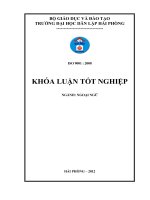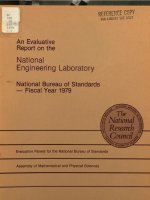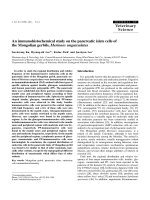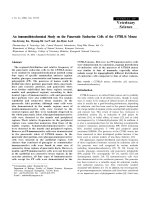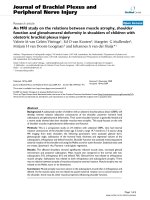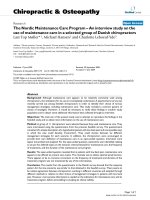An evaluative study on the current final achievement tests for non-English majors at Quang Ninh Teacher Training College
Bạn đang xem bản rút gọn của tài liệu. Xem và tải ngay bản đầy đủ của tài liệu tại đây (295.87 KB, 12 trang )
VIETNAM NATIONAL UNIVERSITY, HA NOI
UNIVERSITY OF LANGUAGES & INTERNATIONAL STUDIES
FACULTY OF POST-GRADUATE STUDIES
VŨ THANH HÒA
AN EVALUATIVE STUDY ON
THE CURRENT FINAL ACHIEVEMENT TESTS FOR NON-ENGLISH
MAJORS AT QUANG NINH TEACHER TRAINING COLLEGE
ĐÁNH GIÁ BÀI KIỂM TRA CUỐI KỲ CHO SINH VIÊN
KHÔNG CHUYÊN NGỮ TRƯỜNG CAO ĐẲNG SƯ PHẠM QUẢNG NINH
M.A. MINOR PROGRAMME THESIS
Field: English Teaching Methodology
Code: 60 140 111
HANOI – 2016
VIETNAM NATIONAL UNIVERSITY, HA NOI
UNIVERSITY OF LANGUAGES & INTERNATIONAL STUDIES
FACULTY OF POST-GRADUATE STUDIES
VŨ THANH HÒA
AN EVALUATIVE STUDY ON
THE CURRENT FINAL ACHIEVEMENT TESTS FOR NON-ENGLISH
MAJORS AT QUANG NINH TEACHER TRAINING COLLEGE
ĐÁNH GIÁ BÀI KIỂM TRA CUỐI KỲ CHO SINH VIÊN
KHÔNG CHUYÊN NGỮ TRƯỜNG CAO ĐẲNG SƯ PHẠM QUẢNG NINH
M.A. MINOR PROGRAMME THESIS
Field: English Teaching Methodology
Code: 60 140 111
Supervisor: Đỗ Thị Thanh Hà, Ph.D
HANOI – 2016
CANDIDATE’S STATEMENT
-----------***-----------
I, Vu Thanh Hoa, hereby certify that this minor thesis entitled
AN EVALUATIVE STUDY ON THE CURRENT FINAL ACHIEVEMENT
TESTS FOR NON – ENGLISH MAJORS AT QUANG NINH TEACHER
TRAINING COLLEGE
is completely the result of my own work for the Degree of Master at University of
Languages and International Studies, Vietnam National University, Hanoi and that
this thesis has not been submitted for any degree at any other university or
institution.
1
ACKNOWLEDGEMENTS
I would like to express my gratitude to all those who have given me the possibility
and motivation to complete this thesis.
First and foremost, I am deeply indebted to my supervisor, Dr. Do Thi Thanh Ha,
for her wholehearted guidance, invaluable suggestions, thoughtful comments and
useful materials during the time of writing this thesis.
Second, I would also like to acknowledge my debt of gratitude to the staff members
of the Faculty of Post-Graduate Studies and the lecturers at University of Languages
and International Studies, Vietnam National University-Hanoi for their valuable
lectures, which laid the foundation for this thesis and for their knowledge as well as
their sympathy.
Third, a special thank would also go to the teachers and the non-English majors at
Quang Ninh Teacher Training College, who took part in the research. Without their
participation and cooperation I would not be able to complete this research paper.
Fourth, I should be grateful to the librarians at ULIS for their constant help thanks
to which I was able to access to all materials needed to accomplish the thesis.
Finally but importantly, I would like to express my appreciation to my family and
my friends who have been continuously giving me a lot of support and
encouragement for the fulfillment of this challenging work.
Hanoi, 2016
2
ABSTRACT
The study was intended to give an evaluation on the current final achievement tests
for non English majors at QNTTC from perspectives of the teachers and nonEnglish majors at QNTTC. In addition, this study also investigated how the current
final achievement tests for non-English majors at QNTTC aligned to the CEFR.
The study was carried out by means of two sets of survey questionnaires, and
analysis of the current final achievement tests at QNTTC and the CEFR, using
some softwares.
From perspectives of the students, some test items of these tests such as phonetics,
vocabulary and grammatical structures were too difficult for them to do.
The teachers found that the current final achievement tests at QNTTC were not
very reasonable because they lacked two skills: speaking and listening and the
writing section did not test some useful skills such as writing letters, writing cards,
creating stories.
The analysis of the alignment between the current final achievement tests at
QNTTC and the CEFR showed that most of the vocabulary and test items in these
tests were in the ranges from levels A2 to B1 and some of them were at level A2
and did not reach the target level, B1. Moreover, the current final achievement
tests at QNTTC differed from other international tests (PET) in terms of length and
constructs.
The study will hopefully contribute to the test making at QNTTC by showing an
example of evaluation on the current final achievement tests for non-English
majors at QNTTC and the alignment between these tests and the CEFR.
3
CHAPTER 1. INTRODUCTION
1.1 Rationale of the study
Nowadays English has become increasingly important as a means of global
communication. In the process of global integration, Vietnam has realized the
importance of English language learning and teaching; Thus, English has been
widely used in many fields and it has become a compulsory subject at many
schools and universities.
Quang Ninh Teacher Training College (QNTTC) was established in 1959 and now
it is considered the oldest institution in providing undergraduate teacher education
in Quang Ninh. In 1991, the organization was restructured from four provincial
teacher training institutions (TTI): Quang Ninh Early childhood TTI, Quang Ninh
Primary TTI, Quang Ninh Education Management TTI and Quang Ninh Low
Secondary TTI. Having awareness of the importance of English, the college
authorities have paid due attention to the matter of improving the quality of teaching
and learning English.
In the teaching and learning in general and in the teaching and learning foreign
language process in particular, testing and assessment play a significant role. The
importance of language testing is recognised by virtually all professionals in the
language education. Teachers should not be confined to imparting teaching and
learning with testing. Testing is of special importance in educational system that is
highly competitive as testing is not only an indirect stimulus to learning, but plays a
crucial role in determining the success or failure of an individual’s career with
direct implications for his future career. In the World Yearbook of education 1969,
Lauwerys and Seaton state: “Thus, testing is an important tool in educational
research and for programme evaluation, and may even throw light on both the
nature of language proficiency and language learning.”
4
Nga (1997:1) shares the same idea: “Tests are assumed to be powerful determiners
of what happens in classrooms and it is commonly claimed that they affect
teaching and learning activities both directly and indirectly”.
It cannot be denied that testing is an important part in teaching and learning
process, but has it been paid enough attention yet? Having taught English for
students at a high school and then at QNTTC for 5 years, the author of this study
has designed tests for both English majors and non-English majors. She has also
administered and marked these tests. Her teaching experience shows that there still
remain some problems that need to be solved such as the test content, the gap
between what is tested and what is taught, the reuse of tests from years to years,
from classes to classes. As a result, tests may lack validity and reliability. Hughes
(1990:1) also gives another comment on recent language testing: “It cannot be
denied that a great deal of language testing is of very poor quality. Too often
language tests have a harmful effect on teaching and learning and too often they
fail to measure accurately whatever it is they are intended to measure”. Moreover,
teachers frequently lack formal training in educational measurement techniques
and they tend to be alienated from the testing process.
A well designed test is necessary for all language learners even though they have
different levels. On the ground of the problems already mentioned, it is thought
that achievement tests for the non-English majors at QNTTC should be designed to
assure the accuracy and fairness for all students so that they can produce good
backwash in the teachers’ teaching and give students satisfaction and
encouragement in study. Those reasons above encourage me to conduct the study
“An evaluative study on the current final achievement tests for non-English
majors at Quang Ninh Teacher Training College”
1.2 Aims of the study
The study aims at evaluating the current final achievement tests at QNTTC. To
achieve this aim, the following objectives are established:
5
REFERENCES
1. Allen, J.P.B and Corden,Pit, S. (1974). Techniques in applied Linguistics.
Oxford University Press.
2. Aik, K.C. (1983). Continuous Prose Writing Test for Business studies students.
(In) Guidelines: Periodical for Classroom Language teachers Classroom tests.
Crabbe, D.(Ed). Vol.5.Pp.72-75
3. Anastasi, A. (1982). Psychological testing. London: Macmillan.
4. Bachman, L.F (1990). Fundamental Considerations in Language Testing.
Oxford University Press.
5. Bachman, L.F. and Palmer, A.S., (1996). Language testing in Practice:
Designing and Developing Useful Language Tests. Oxford University Press.
6. Baker, D. (1989). Language Testing: A Critical Survey and Practical Guide.
London: Edward Arnold.
7. Broughton, G., Brumfit, C., Flavell, R., Hill, P., & Pincas, A. (1990). Teaching
English Foreign Language. London: Routledge Education Books.
8. Brown, F.G (1971). Measurement and Evaluation, Ilasca,III.:F.E., Peacock.
9. Brown, H.D (1994a). Teaching by Principles – An Interactive Approach to
Language Pedagogy. Englewood Cliffs NJ: Prentice-Hall.
10. Brown, H.D (1994b). Principles of Language Learning and Teaching.
Englewood Cliffs NJ: Prentice-Hall.
11. Brown, J.D (1995). The Elements of Language Curriculum: A systematic
Approach to Program Development. Boston, Massachusetts: Heinle & Heinle
Publishers.
12. Carmen, P.B. (1995). (In) Coming to Grips with Progress Testing. In
forum magazine, 33(3), 09-55.
6
13. Carroll, B.J. (1968). The psychology of language testing. (In) A. Davies (Ed).
Language Testing symposium. A Psycholinguistic Perspective. London: Oxford
University Press.
14. Carroll, B.J. and Hall, P.J. (1985). Make Your Own Language Tests: A
Practical Guide to Writing Language Performance Tests. Pergamon, Oxford.
15. Council of Europe (2001): Common European Framework of Reference for
Languages: learning, teaching and assessment. Cambridge: Cambridge
University Press.
16. Davidson, F & Fulcher, G (2007). 'The Common European Framework of
Reference and the design of language tests: A matter of effect', Language
Teaching, 40, 231-241.
17. Hai, H.N. (1999). Reading Comprehension Tests for Intermediate Students at
Hanoi University of Foreign Studies. Unpublished MA dissertation. Hanoi:
Hanoi University of Foreign Studies.
18. Harrison, A. (1983a). A Language Testing Handbook. Macmillan Publishers.
19. Harrison, A. (1983b). Communicative Testing Jam Tomorrow? (In) Current
Developments in Language Testing. Hughes, A. & Porter, D. (Eds) London:
Academic Press.
20. Heaton, J.B. (1988). Writing English Language Tests. London: Longman.
21. Henning, G. (1987). A Guide to Language Testing. Cambridge: Newbury
House Publishers.
22. Hughes, A. ( 1990). Testing for Language Teachers. Cambridge University
Press.
23. Lauwerys, J.A., and Seanlon, D.G. (1969). The World Year Book of Education
1969. London: Evans.
24. McNamara, T. (2000). Language Testing. New York: Oxford University Press.
7
25. Milanovic, M (2009). 'Cambridge ESOL and the CEFR', Research Notes, 37,
2-5.
26. Moore, K.D. ( 1992). Classroom Teaching Skills. USA: Mc Graw Hill, Inc.
27. Nga, N.P. (1997). Wash back effects of the International English Language
Testing System at the Vietnam National University, Hanoi. Unpublished Ph.D.
thesis. The university of Melbourne: Australia.
28. Nga, N. P. (1999). MA (TESOL). Testing Programme. Hanoi: VNU, Hanoi
College of Foreign Languages.
29. Penny Ur. 1996). A Course in Language Teaching: Practice and theory.
Cambridge Teacher Training and Development.
30. Read, J.A.S. (1983). What is a Good Classroom Test? (In) Guidelines A
Periodical for Classroom Language Teachers. Classroom tests. Crabbe, D. (Ed).
Volum 5. No.1.Pp.1-7. Singapore: SEAMEO Regional Language Centre.
31. Sarah Cunningham, Peter Moor and Jane Comyns Carr. New Cutting Edge –
Pre Intermediate. Longman Publishers.
32. Spiros Papagoergiou, Richard J. Tannnebaum, Brent Bridgeman, Yeonsuck
Cho (2015). “The Association between TOEFL iBT Test Scores and the Common
European Framework of Reference (CEFR) levels”. Research Memorandum.
33. Valette, R.M. (1977). Modern Language Testing. New York: Harcourt Brace
Jovanovic Publishers.
34. Weir, C J (2005). 'Limitations of the Common European Framework for
developing comparable examinations and tests'. Language Testing, 22, 281-300.
35. Announcement 681/TB-BGDĐT dated 30 May, 2013.
36. Decision 66/2008/QĐ – BGDĐT dated 2 December, 2008 of the Ministry of
Education.
8
37. Đề án chuẩn hóa năng lực ngoại ngữ cho Cán bộ và Sinh viên của Đại học Thái
Nguyên giai đoạn 2013 – 2015 và 2016 – 2020 (2013).
38. English Grammar Profile [web-based software] by Council of Europe, retrieved
October
1,
2015
from:
lish-grammar-
profile/egp-online.
39. English Vocabulary Profile [web-based software] by Council of Europe,
retrieved
October
1,
2015
from:
/>40. CEF - Estim Grid by European Centre for Modern Languages (2010).
Retrieved November 2015.
41. Pearson Reading Maturity Metric Beta [web-based software] by Pearson
Education,
retrieved
October
1,
2015
from:
-web/#/
42. Using the CEFR: Principles of good practice. (2011). University of
Cambridge, ESOL examinations.
9
I


